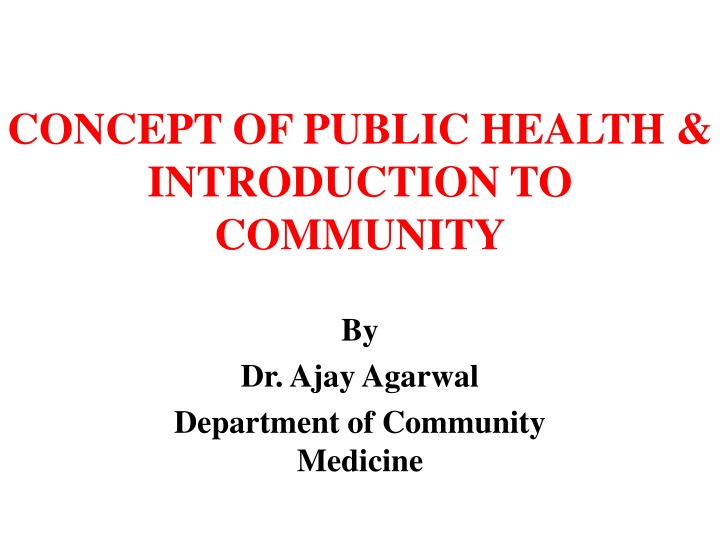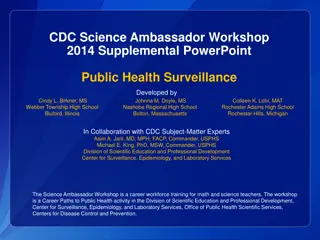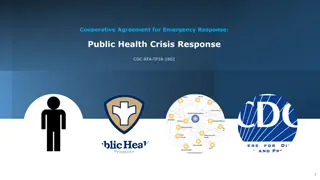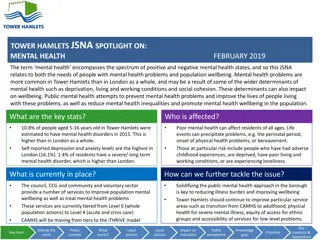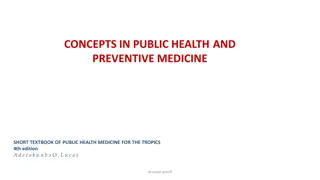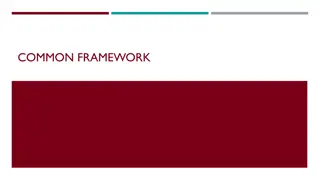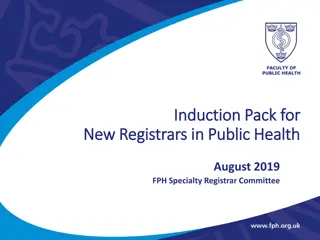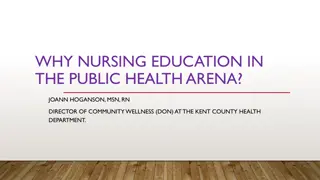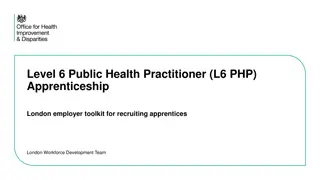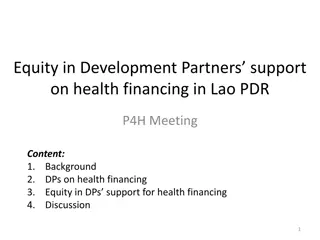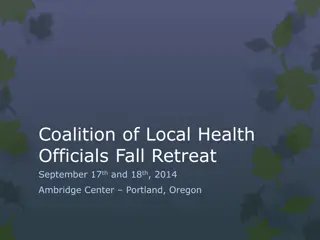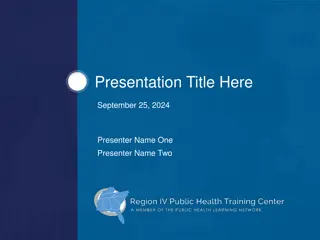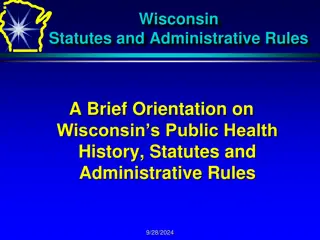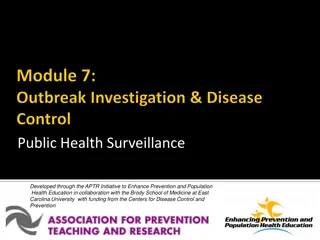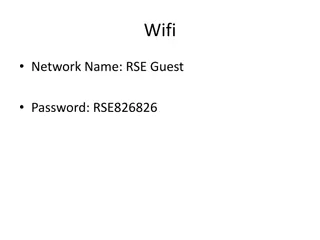Introduction to Public Health Concepts
Public health encompasses efforts to promote, protect, and preserve community health through organized strategies and interventions. It involves a combination of preventive measures, health education, disease control, and environmental monitoring to improve overall well-being. This collection illustrates the core principles and practices of public health as defined by prominent experts in the field.
Download Presentation

Please find below an Image/Link to download the presentation.
The content on the website is provided AS IS for your information and personal use only. It may not be sold, licensed, or shared on other websites without obtaining consent from the author.If you encounter any issues during the download, it is possible that the publisher has removed the file from their server.
You are allowed to download the files provided on this website for personal or commercial use, subject to the condition that they are used lawfully. All files are the property of their respective owners.
The content on the website is provided AS IS for your information and personal use only. It may not be sold, licensed, or shared on other websites without obtaining consent from the author.
E N D
Presentation Transcript
CONCEPT OF PUBLIC HEALTH & INTRODUCTION TO COMMUNITY By Dr. Ajay Agarwal Department of Community Medicine
PUBLIC HEALTH The BigPicture
WHAT IS PUBLIC HEALTH? The sum of allofficial or governmental efforts to promote, protect, and preserve the people s health.
PUBLIC HEALTH The science and art of preventing disease, prolonging life and promoting health and efficiency through organized community effort. -CEA Winslow, 1920 The process of mobilizing and engaging local, state, national, and international resources to assure the conditions in which people can be healthy -The Oxford Textbook of Public Health
PUBLIC HEALTH The science and practice of protecting and improving the health of the community, as by preventive medicine, health education, control of communicable diseases, application of sanitary measures, and monitoring of environmental hazards. -The American Heritage Dictionary of PublicHealth
PUBLIC HEALTH Public health is what we, as a society, do collectively to assure the conditions in which people can be healthy. -Source: Institute of Medicine Report (IOM).THE FUTURE OF PUBLIC HEALTH. Washington DC: National Academy Press. 1988. Public health is a science and art of saving the lives of millions at once by single decision or intervention.
PUBLIC HEALTH ASystem AProfession AMethod Government Service The Health of the Public
PUBLIC HEALTH APPROACH Public Health Model Medical Model Versus
PUBLIC HEALTH APPROACH Public Health Model Population Disease Prevention Health Promotion Interventions Environment Human behavior Public (Some p r i v a t e) Medical Model Individual Diagnosis Treatment Intervention Medical care Private (Somep u b l i c)
CORE ACTIVITIES OF PUBLIC HEALTH 1. Prevents epidemics and the spread of disease 2. Protects against environmental hazards 3. Responds to disasters and assists communities in recovery 4. Prevents injuries 5. Promotes healthy behaviors 6. Assures the quality, accessibility and accountability of health services
CORE ACTIVITIES OF PUBLIC HEALTH Monitoring the health status of the population 7. Mobilizing community action 8. Reaching out to link high-risk and hard-to-reach people to needed services 9. 10. Researching to develop new insights and innovative solutions 11. Leading the development of sound health policy and planning
GREAT PUBLIC HEALTH ACHIEVEMENTS Vaccination Motor-vehicle safety Safer workplaces Control ofinfectious diseases Decline in deathsf r o m coronary heart disease and stroke Safer and healthie r foods Healthier mothersa n d babies Family planning Fluoridation ofdrinkin g water Recognition oftob acco use as a health hazard CDC, 1999
PUBLIC HEALTH PROBLEMS AND DISEASES Communicable disease Non communicable diseases Environmental pollution MCH problems Malnutrition and micronutrient deficiency Municipal and hospital waste Geriatric health problems Population problems Measles Influenza Poliomyelitis Tuberculosis Cholera Dengue Malaria HIV/AIDS Obesity Cancer Diabetes
PUBLIC HEALTH ORGANIZATIONS Non Governmental National NFHP FPAN Nepal Red Cross PLAN Nepal International CARE United Mission to Nepal Save the Children Marie Stopes International Family Health International United Nation WHO WFP FAO UNICEF UNDP
PUBLIC HEALTH ORGANIZATIONS Governmental District health office Public health office Regional health directorate Regional training center Department of health services Ministry of health and population Primary health care institutions Others Academic institutions Research organizations Community development organizations Quality control offices Health training centers Local development offices
SAMPLING OF PUBLIC HEALTH PROFESSIONS Gerontological health HIV/AIDS Injury control and emergency health Services International Health Mental Health Oral Health Public Health Nursing School Health Education and Services Women s health and gender development Population, Family Planning & Reproductive Health Maternal Child health Public Health Education and Health Promotion Community health planning and policy development Public health administration Epidemiology and disease control Alcohol, tobacco and other drugs Environmental & occupational health and safety Food and nutrition
RISE OF PUBLIC HEALTH Johanna Peter Frank (1745-1821) public health as good health laws & State is responsible for health of its people Public Health Act 1848 Cholera epidemic of 1832 & report of Chadwick is called father of public health John Snow 1848-1854 studied the role of polluted drinking water in the spread of cholera William Budd 1856 outbreak of typhoid fever spread by drinking water
Public Health Act of 1875 for control of man s physical environment Sir John Simon (1816-1904) first medical officer of Health of London done sanitary reforms & built up system of public health in London disease control phase (1880-1920) lemuel Shattuck (1793-1859 ) in America published report on health condition to improvement of public health Clean water , clean surrounding, wholesome condition of houses, control of offensive trades establishment of W.H.O .provide a Health Charter for all people
CHANGING CONCEPTS IN PUBLIC HEALTH FOUR PHASES 1-DISEASE CONTROL PHASE (1880-1920) during 19th century sanitary legislation & sanitary reforms aimed at control of man s physical environment water supply sewage disposal etc. 2-HEALTH PROMOTIONAL PHASE (1920- 1960) public health had neglected the citizen as individual , & state has direct responsibility for the health of individual health, promotion of individual & Mother & child health services, school health services, industrial health services mental health & rehabilitation services
Winslow (1920) the science & art of preventing disease, prolonging life & promoting health & efficacy through organizing community effort Provision of basic health services through primary health centre & subcentres for rural & urban area Community Development Programme to promote through active participation of whole community & on the initiative of the community
CHANGING CONCEPTS IN PUBLIC HEALTH 3-SOCIAL ENGINEERING PHASE (1960-1980) acute illness problems were solved new health problems in form of chronic diseases began to emerge so new concept as risk factors as detriments of these diseases. Social & behavioral aspect of disease & health Prevention of disease, promotion of health & prolongation of life.
4- HEALTH FOR ALL PHASE (1981- 200A.D.)- contrast in health of developed & developing country enjoys all detriments of good health adequate income , nutrition, education, sanitation safe drinking water & comprehensive health care in contrast only 10-20% in developing country W.H.O. to provide Health For All by year 2000
INTRODUCTION TO COMMUNITY AND COMMUNITYHEALTH CONCEPTS
DEFINITION A community is a social group determined by geographical boundaries and/ or common values and interest. Its members know and interact with each other. It functions within a particular structure and exhibits and creates certain norms, values and social institutions .. WHO expert Committee (1974)
FAMILY AND COMMUNITY MEDICINE 1923 Dr. Francis Peabody specialization had already reached its apex & for rapid return of general physician ( family physician) who would give comprehensive & personalized care.
FAMILY MEDICINE Human, social & cultural aspect of health & disease & recognition of family as a focal point of health care & for integrating preventive, promotive & curative services. a field of specialization in medicine which is neither disease nor organ oriented medicine or health care centered on family as a unit from first contact to on going care of chronic problem (from preventive to rehabilitation )
COMMUNITY MEDICINE Successor of public health, community health, preventive & social medicine prevention of disease & promotion of health specialty which deals with populations & comprises those doctors who try to measure the need of population, both sick & well, who plan & administer services to meet these needs, & those who are engaged in research & teaching in the field
CHARACTERISTICS 1. The community has a defined geographical boundaries which has the beginning and the end.
The boundaries of a small community such as hamlet, village etc are distinct whereas that of a large community such as town, city etc are indistinct.
2. The community is composed of people who live together in the defined boundaries of the community.
3. The community people have common psychological characteristics i.e., there is similarity in language, life style, customs and traditions etc. They share common interests, values, moral norms and codes.
4. The people in the community interact with each other and have free communication.
5. The community has organized social structure and system and common organization which carry various functions such as housing, food, agriculture, animal husbandry, health, education, marketing, banking etc.
FUNCTIONS 1. It provides space for housing, shelter, socialization and recreation. 2. It provides means and facilities for livelihood.
3. Community provides opportunity for employment. 4. It takes care off socialization and education of its members.
5. It provides safety and security for its members by enforcement of norms and legislation formulated by the society. 6. It provides opportunities for people participation and communication.
COMMUNITY HEALTH- DEFINITION Community HEALTH REFERS TO THE HEALTH Status of the members of the community, to the problems affecting their health and to the totality of health care provided to the community .. WHO (1971)
C.E.AWINSLOW Is the father of public health. He defines public health as follows.
Public health is the science and art of preventing diseases, prolonging life and promoting health and efficiency through organized community efforts for the sanitation of environment the control of diseases, the education of individuals in personal hygiene, the organization of medical and nursing services for early diagnosis and preventive treatment of diseases and
Cont the control of diseases, the education of individuals in personal hygiene, the organization of medical and nursing services for early diagnosis and preventive treatment of diseases and the development of social machinery to ensure for every individual a standard of living adequate for maintenance of health, so organizing these benefits as to enable every citizen to realize the birth right of health and longevity
C.E.A WINSLOW CONCEPT OF COMMUNITYHEALTH
OBJECTIVE The objective of community health is to provide need based comprehensive services which include the following. 1. Promotion and protection of health i.e. PRIMARY LEVEL PREVENTION. 2. Early diagnosis and treatment and control of further spread of disease i.e. SECONDARY LEVEL PREVENTION. 3. Control of disability and rehabilitation ie. TERTIARY LEVEL OF PREVENTION.
1. Know the community (COMMUNITYIDENTIFICATION). 2. Identify the health needs of the community (COMMUNITY DIAGNOSIS).
COMMUNITY 1. Know the community (COMMUNITY IDENTIFICATION). 2. Identify the health needs of the community (COMMUNITY DIAGNOSIS). 3. Understand underlying factors affecting health problems. 4. Plan and implement comprehensive services.
SOCIAL MEDICINE Neumann(1847) & Virchow (1948) medicine is a social science Alfred Grotjahn (1869-1931) showed that social factor in aetiology of disease 1912 Rene Sand founded Belgian Social Medicine Association man is not only a biological animal, but also a social being, & disease has social causes, social consequences & social therapy social medicine is the study of man as a social being in his total environment Social medicine on two pillars medicine & sociology
